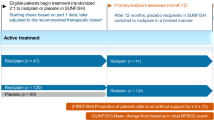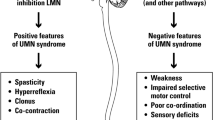Abstract
Mice with a heterozygous knock-out of the myelin protein P0 gene (P0+/−) develop a neuropathy similar to human Charcot–Marie–Tooth disease. They are indistinguishable from wild-types (WT) at birth and develop a slowly progressing demyelinating neuropathy. The aim of this study was to investigate whether the regeneration capacity of early symptomatic P0+/− is impaired as compared to age matched WT. Right sciatic nerves were lesioned at the thigh in 7–8 months old mice. Tibial motor axons at ankle were investigated by conventional motor conduction studies and axon excitability studies using threshold tracking. To evaluate regeneration we monitored the recovery of motor function after crush, and then compared the fiber distribution by histology. The overall motor performance was investigated using Rotor-Rod. P0+/− had reduced compound motor action potential amplitudes and thinner myelinated axons with only a borderline impairment in conduction and Rotor-Rod. Plantar muscle reinnervation occurred within 21 days in all mice. Shortly after reinnervation the conduction of P0+/− regenerated axons was markedly slower than WT, however, this difference decayed with time. Nevertheless, after 1 month, regenerated P0+/− axons had longer strength-duration time constant, larger threshold changes during hyperpolarizing electrotonus and longer relative refractory period. Their performance at Rotor-Rod remained also markedly impaired. In contrast, the number and diameter distribution of regenerating myelinated fibers became similar to regenerated WT. Our data suggest that in the presence of heterozygously P0 deficient Schwann cells, regenerating motor axons retain their ability to reinnervate their targets and remyelinate, though their functional recovery is delayed.




Similar content being viewed by others
References
Sorensen J, Fugleholm K, Moldovan M, Schmalbruch H, Krarup C (2001) Axonal elongation through long acellular nerve segments depends on recruitment of phagocytic cells from the near-nerve environment. Electrophysiological and morphological studies in the cat. Brain Res 903:185–197
Fugleholm K, Schmalbruch H, Krarup C (1994) Early peripheral nerve regeneration after crushing, sectioning, and freeze studied by implanted electrodes in the cat. J Neurosci 14:2659–2673
Fugleholm K, Schmalbruch H, Krarup C (2000) Post reinnervation maturation of myelinated nerve fibers in the cat tibial nerve: chronic electrophysiological and morphometric studies. J Peripher Nerv Syst 5:82–95
Krarup C, Archibald SJ, Madison RD (2002) Factors that influence peripheral nerve regeneration: an electrophysiological study of the monkey median nerve. Ann Neurol 51:69–81
Madison RD, Sofroniew MV, Robinson GA (2009) Schwann cell influence on motor neuron regeneration accuracy. Neuroscience 163:213–221
Filbin MT, Walsh FS, Trapp BD, Pizzey JA, Tennekoon GI (1990) Role of myelin P0 protein as a homophilic adhesion molecule. Nature 344:871–872
Lemke G (1993) The molecular genetics of myelination—an update. Glia 7:263–271
Shapiro L, Doyle JP, Hensley P, Colman DR, Hendrickson WA (1996) Crystal structure of the extracellular domain from P-0, the major structural protein of peripheral nerve myelin. Neuron 17:435–449
Martini R, Schachner M (1997) Molecular bases of myelin formation as revealed by investigations on mice deficient in glial cell surface molecules. Glia 19:298–310
Skre H (1974) Genetic and clinical aspects of Charcot–Marie–Tooth’s disease. Clin Genet 6:98–118
Lupski JR, Reid JG, Gonzaga-Jauregui C, Rio DD, Chen DC, Nazareth L, Bainbridge M, Dinh H, Jing C, Wheeler DA, McGuire AL, Zhang F, Stankiewicz P, Halperin JJ, Yang C, Gehman C, Guo D, Irikat RK, Tom W, Fantin NJ, Muzny DM, Gibbs RA (2010) Whole-genome sequencing in a patient with Charcot–Marie–Tooth neuropathy. N Engl J Med 362:1181–1191
Reilly MM, Shy ME (2009) Diagnosis and new treatments in genetic neuropathies. J Neurol Neurosurg Psychiatry 80:1304–1314
Warner LE, Hilz MJ, Appel SH, Killian JM, Kolodry EH, Karpati G, Carpenter S, Watters GV, Wheeler C, Witt D, Bodell A, Nelis E, Van BC, Lupski JR (1996) Clinical phenotypes of different MPZ (P0) mutations may include Charcot–Marie–Tooth type 1B, Dejerine-Sottas, and congenital hypomyelination. Neuron 17:451–460
Wrabetz L, D’Antonio M, Pennuto M, Dati G, Tinelli E, Fratta P, Previtali S, Imperiale D, Zielasek J, Toyka K, Avila RL, Kirschner DA, Messing A, Feltri ML, Quattrini A (2006) Different intracellular pathomechanisms produce diverse myelin protein zero neuropathies in transgenic mice. J Neurosci 26:2358–2368
Pareyson D, Marchesi C, Salsano E (2009) Hereditary predominantly motor neuropathies. Curr Opin Neurol 22:451–459
Giese KP, Martini R, Lemke G, Soriano P, Schachner M (1992) Mouse P0 gene disruption leads to hypomyelination, abnormal expression of recognition molecules, and degeneration of myelin and axons. Cell 71:565–576
Martini R, Zielasek J, Toyka KV, Giese KP, Schachner M (1995) Protein zero (P0)-deficient mice show myelin degeneration in peripheral nerves characteristic of inherited human neuropathies. Nat Genet 11:281–286
Martini R (1999) P0-deficient knockout mice as tools to understand pathomechanisms in Charcot–Marie–Tooth 1B and P0-related Dejerine-Sottas syndrome. Ann NY Acad Sci 883:273–280
Carenini S, Mäurer M, Werner A, Blazyca H, Toyka KV, Schmid CD, Raivich G, Martini R (2001) The role of macrophages in demyelinating peripheral nervous system of mice heterozygously deficient in p0. J Cell Biol 152:301–308
Schmid CD, Stienekemeier M, Oehen S, Bootz F, Zielasek J, Gold R, Toyka KV, Schachner M, Martini R (2000) Immune deficiency in mouse models for inherited peripheral neuropathies leads to improved myelin maintenance. J Neurosci 20:729–735
Wolthers M, Moldovan M, Binderup T, Schmalbruch H, Krarup C (2005) Comparative electrophysiological, functional, and histological studies of nerve lesions in rats. Microsurgery 25:508–519
Bostock H, Cikurel K, Burke D (1998) Threshold tracking techniques in the study of human peripheral nerve. Muscle Nerve 21:137–158
Kiernan MC, Burke D, Andersen KV, Bostock H (2000) Multiple measures of axonal excitability: a new approach in clinical testing. Muscle Nerve 23:399–409
Nodera H, Bostock H, Kuwabara S, Sakamoto T, Asanuma K, Jia-Ying S, Ogawara K, Hattori N, Hirayama M, Sobue G, Kaji R (2004) Nerve excitability properties in Charcot–Marie–Tooth disease type 1A. Brain 127:203–211
Moldovan M, Krarup C (2004) Persistent abnormalities of membrane excitability in regenerated mature motor axons in cat. J Physiol 560:795–806
Moldovan M, Krarup C (2004) Mechanisms of hyperpolarization in regenerated mature motor axons in cat. J Physiol 560:807–819
Moldovan M, Krarup C (2007) Internodal function in normal and regenerated mammalian axons. Acta Physiol (Oxf) 189:191–200
Moldovan M, Alvarez S, Pinchenko V, Klein D, Nielsen FC, Wood JN, Martini R, Krarup C (2011) Nav1.8 channelopathy in mutant mice deficient for myelin protein zero is detrimental to motor axons. Brain 134:585–601
Moldovan M, Krarup C (2006) MTRACK, a software system to facilitate the development of threshold tracking methods. Clin Neurophysiol 117:S231
Moldovan M, Alvarez S, Krarup C (2009) Motor axon excitability during Wallerian degeneration. Brain 132:511–523
Boërio D, Greensmith L, Bostock H (2009) Excitability properties of motor axons in the maturing mouse. J Peripher Nerv Syst 14:45–53
Boërio D, Kalmar B, Greensmith L, Bostock H (2010) Excitability properties of mouse motor axons in the mutant SOD1(G93A) model of amyotrophic lateral sclerosis. Muscle Nerve 41:774–784
Tomlinson S, Burke D, Hanna M, Koltzenburg M, Bostock H (2010) In vivo assessment of HCN channel current (I(h)) in human motor axons. Muscle Nerve 41:247–256
Mogyoros I, Lin CS, Kuwabara S, Cappelen-Smith C, Burke D (2000) Strength–duration properties and their voltage dependence as measures of a threshold conductance at the node of Ranvier of single motor axons. Muscle Nerve 23:1719–1726
Mogyoros I, Kiernan MC, Burke D (1996) Strength–duration properties of human peripheral nerve. Brain 119:439–447
Bostock H (1983) The strength-duration relationship for excitation of myelinated nerve: computed dependence on membrane parameters. J Physiol 341:59–74
Barrett EF, Barrett JN (1982) Intracellular recording from vertebrate myelinated axons: mechanism of the depolarizing afterpotential. J Physiol 323:117–144
Hockly E, Woodman B, Mahal A, Lewis CM, Bates G (2003) Standardization and statistical approaches to therapeutic trials in the R6/2 mouse. Brain Res Bull 61:469–479
Baker M, Bostock H, Grafe P, Martius P (1987) Function and distribution of three types of rectifying channel in rat spinal root myelinated axons. J Physiol 383:45–67
Pape HC (1996) Queer current and pacemaker: the hyperpolarization-activated cation current in neurons. Annu Rev Physiol 58:299–327
Sancho S, Magyar JP, Aguzzi A, Suter U (1999) Distal axonopathy in peripheral nerves of PMP22-mutant mice. Brain 122(Pt 8):1563–1577
Fabrizi GM, Simonati A, Morbin M, Cavallaro T, Taioli F, Benedetti MD, Edomi P, Rizzuto N (1998) Clinical and pathological correlations in Charcot–Marie–Tooth neuropathy type 1A with the 17p11.2p12 duplication: a cross-sectional morphometric and immunohistochemical study in twenty cases. Muscle Nerve 21:869–877
Bosboom WM, van den Berg LH, Franssen H, Giesbergen PC, Flach HZ, van Putten AM, Veldman H, Wokke JH (2001) Diagnostic value of sural nerve demyelination in chronic inflammatory demyelinating polyneuropathy. Brain 124:2427–2438
Guy J, Ellis EA, Hope GM, Emerson S (1991) Maintenance of myelinated fibre g ratio in acute experimental allergic encephalomyelitis. Brain 114(Pt 1A):281–294
Behse F, Buchthal F, Carlsen F, Knappeis GG (1972) Hereditary neuropathy with liability to pressure palsies. Electrophysiological and histopathological aspects. Brain 95:777–794
Keller MP, Chance PF (1999) Inherited peripheral neuropathy. Semin Neurol 19:353–362
Thomas FP, Lebo RV, Rosoklija G, Ding XS, Lovelace RE, Latov N, Hays AP (1994) Tomaculous neuropathy in chromosome 1 Charcot–Marie–Tooth syndrome. Acta Neuropathol 87:91–97
Zielasek J, Martini R, Toyka KV (1996) Functional abnormalities in P0-deficient mice resemble human hereditary neuropathies linked to P0 gene mutations. Muscle Nerve 19:946–952
Lewis RA, Sumner AJ, Shy ME (2000) Electrophysiological features of inherited demyelinating neuropathies: a reappraisal in the era of molecular diagnosis. Muscle Nerve 23:1472–1487
Ey B, Kobsar I, Blazyca H, Kroner A, Martini R (2007) Visualization of degenerating axons in a dysmyelinating mouse mutant with axonal loss. Mol Cell Neurosci 35:153–160
Wujek JR, Lasek RJ (1983) Correlation of axonal regeneration and slow component B in two branches of a single axon. J Neurosci 3:243–251
Braendgaard H, Sidenius P (1986) Anterograde components of axonal transport in motor and sensory nerves in experimental 2,5-hexanedione neuropathy. J Neurochem 47:31–37
Fugleholm K, Sørensen J, Schmalbruch H, Krarup C (1998) Axonal elongation through acellular nerve segments of the cat tibial nerve: importance of the near-nerve environment. Brain Res 792:309–318
Moldovan M, Krarup C (2006) Evaluation of Na+/K+ pump function following repetitive activity in mouse peripheral nerve. J Neurosci Methods 155:161–171
Martini R, Xin Y, Schmitz B, Schachner M (1992) The L2/HNK-1 carbohydrate epitope is involved in the preferential outgrowth of motor neurons on ventral roots and motor nerves. Eur J Neurosci 4:628–639
Brushart TM (1988) Preferential reinnervation of motor nerves by regenerating motor axons. J Neurosci 8:1026–1031
Robinson GA, Madison RD (2009) Influence of terminal nerve branch size on motor neuron regeneration accuracy. Exp Neurol 215:228–235
Brushart TM (1993) Motor axons preferentially reinnervate motor pathways. J Neurosci 13:2730–2738
Goldman L, Albus JS (1968) Computation of impulse conduction in myelinated fibers: theoretical basis of the velocity diameter relation. Biophys J 8:596–607
Erlanger J, Schoepfle GM (1946) A study of nerve degeneration and regeneration. Am J Physiol 147:550–581
Gutmann E, Sanders FK (1943) Recovery of fibre numbers and diameters in the regeneration of peripheral nerves. J Physiol 101:489–518
Sanders FK, Whitteridge D (1946) Conduction velocity and myelin thickness in regenerating nerve fibers. J Physiol 105:152–174
Vizoso AD, Young JZ (1948) Internode length and fibre diameter in developing and regenerating nerves. J Anat 82:110–134
Ritchie JM (1982) On the relation between fibre diameter and conduction velocity in myelinated nerve fibres. Proc R Soc Lond Ser B Biol Sci 217:29–35
Bostock H, Rothwell JC (1997) Latent addition in motor and sensory fibres of human peripheral nerve. J Physiol 498:277–294
Panizza M, Nilsson J, Roth BJ, Rothwell J, Hallett M (1994) The time constants of motor and sensory peripheral nerve fibers measured with the method of latent addition. Electroencephalogr Clin Neurophysiol 93:147–154
Acknowledgments
The project was supported by Lundbeck Foundation, the Novo Nordisk Foundation, the Danish Medical Research Council, the Ludvig and Sara Elsass Foundation, the Foundation for Research in Neurology and Jytte and Kaj Dahlboms Foundation. We would like to thank Lis Hansen for expert technical assistance with histological preparations.
Author information
Authors and Affiliations
Corresponding author
Additional information
Special Issue: In Honor of Elisabeth Bock.
Rights and permissions
About this article
Cite this article
Rosberg, M.R., Alvarez, S., Krarup, C. et al. Functional Recovery of Regenerating Motor Axons is Delayed in Mice Heterozygously Deficient for the Myelin Protein P0 Gene. Neurochem Res 38, 1266–1277 (2013). https://doi.org/10.1007/s11064-013-1030-3
Received:
Revised:
Accepted:
Published:
Issue Date:
DOI: https://doi.org/10.1007/s11064-013-1030-3




